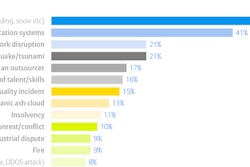The current hyper-reactive global economy as well as unforeseen weather anomalies can magnify the suddenness and breadth of disruptions in the supply chain. Any number of factors can potentially wreak havoc.
Even if you have an overall planning process in place, with established long-term goals, short-term contingency plans tend to receive less considered thought. Rarely do they result in quick and decisive action when it is most needed. Below are some contingency measures you can take proactively to limit risk exposure and enable rapid and effective crisis management.
1. Develop a Plan
Form a contingency team composed of key supply chain partners (e.g., from the OEM, manufacturing and logistics sides), and identify contingency scenarios:
¦ Re-examine sourcing partnerships, identify alternatives.
¦ Model the impact of disruptions on your sourcing and inventory strategies.
¦ Identify a core contingency inventory strategy – in what form and quantity across the entire procurement, manufacturing and distribution network – to be fine-tuned as the need arises.
¦ Develop a list of appropriate immediate and follow-up actions to achieve an optimal outcome for each contingency scenario, and, most important, appoint a point person to take charge of each contingency.
2. Create Visibility
It is essential that all networks linking trading partners support end-to-end visibility and that all network partners participate in contingency strategies. In this way you can monitor supplier performance in real-time and address any variances in your risk management system.
3. Build Flexibility
An agile supply chain can help mitigate risks. Look at opportunities to alleviate current supply chain bottlenecks, model alternative transportation network configurations and look for alternative sources of supply.
4. Respond Decisively
Proactively link contingency plans and business objectives, and assure that contingency point people have previously obtained corporate authority and buy-in for the rapid execution of contingency strategies.
5. Continuously Improve the Plan
Continuously optimize inventories against long-term business objectives as well as changing market conditions, supply constraints, customer bankruptcies and other contingency scenarios.
As significant business, currency rates, fuel costs and other changes occur, re-examine supply chain decisions from materials procurement, manufacturing, inventories, distribution, transportation, to constraints and costs.
















![Pros To Know 2026 [color]](https://img.sdcexec.com/mindful/acbm/workspaces/default/uploads/2025/08/prostoknow-2026-color.mduFvhpgMk.png?ar=16%3A9&auto=format%2Ccompress&bg=fff&fill-color=fff&fit=fill&h=135&q=70&w=240)